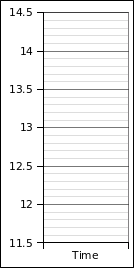| Table One |
|---|
| Name | Country | Time (s) |
|---|
| WISIL Toea | Papua NG | 11.6 |
| COLLEY Saruba | Gambia | 12.21 |
| PRETELLI Martina | San Marino | 12.41 |
| LOPES Lidiane | Cape Verde | 12.72 |
| GEZAH Hala | Libya | 13.24 |
| RIJAL Pramila | Nepal | 13.33 |
| ALATOA Janice | Vanuatu | 13.6 |
| WENDOLIN Mihter | FSM | 13.67 |
| KOHISTANI Tahmina | Afghanistan | 14.42 |
test 02 sc3 Name:
For this section of the midterm, use the time data (third column) in seconds from the London 2012 Olympics Preliminary Heat 4 Women's 100mheld on Friday, 03 August 2012 10:40.
- ____________________ Determine the level of measurement for the data.
- __________ Calculate the sample size n.
- __________ Calculate the minimum.
- __________ Calculate the maximum.
- __________ Calculate the range.
- __________ Calculate the midrange.
- __________ Calculate the mode.

- __________ Calculate the median.
- __________ Calculate the mean.
- __________ Calculate the sample standard deviation.
- __________ Shelly-Ann Fraser-Pryce won the gold medal in the 100 meters with a time of 10.75 seconds. Use the mean and standard deviation above to calculate the z-score for 10.75 seconds.
- __________ Calculate the sample coeficient of variation.
 __________ Calculate the first quartile.
__________ Calculate the first quartile.- __________ Calculate the third quartile.
- __________ Calculate the Inter-Quartile Range.
-
Make a sketch of the box plot for this time data.
- __________ If the time data is divided into three classes, what is the width of a single class?
-
Determine the frequency and calculate the relative frequency for the data using three classes.
Record your results in the table provided.
| Class upper limits | Frequency F | Rel. Freq. |
|---|
| | |
| | |
| | |
| Sums: | | |
- Sketch a frequency histogram for the time data, labeling your horizontal axis and vertical axis as appropriate.
- __________ What is the shape of the histogram?
- __________ Based on the data above, what is the probability of a time of less than 12.54 seconds?
| Distance (m) | Split (s) |
|---|
| 0 | 0 |
| 400 | 75 |
| 800 | 144 |
| 1500 | 250 |
The 1500 meter women's final was the
slowest in the history
of the Olympics since women began running the 1500m race in 1972.
The table is the split times from the 1500 meter women's track final in London 2012. The slow pace
meant that anyone in the field had a good opportunity to win which led to an upset victory by three
lesser known runners, Asli Cakir Alptekin of Turkey gold (27 years old), Gamze Bulut of Turkey silver
(20 years old), and Maryam Yusuf Jamal of Bahrain bronze (born in Ethiopia, 28 years old).
- _________ Calculate the sample size n (the number of data pairs).
- ______________ Calculate the slope of the linear regression for the data. For this data, keep at least THREE non-zero digits in your slope answer!
- ______________ Calculate the y-intercept of the linear regression for the data.
- ______________ Is the relation positive, negative, or neutral?
- ______________ Calculate the correlation coefficient r for the data.
- ______________ Is the correlation none, weak/low, moderate, strong/high, or perfect?
- ______________ Determine the coefficient of determination.
- ______________ Use the slope and intercept to predict the split time at 1200 meters.
- ______________ Use the slope and intercept to predict the distance which the women would cover in the 143 seconds Dana takes to run a lap of the track.

 __________ Calculate the first quartile.
__________ Calculate the first quartile.
 __________ Calculate the first quartile.
__________ Calculate the first quartile.